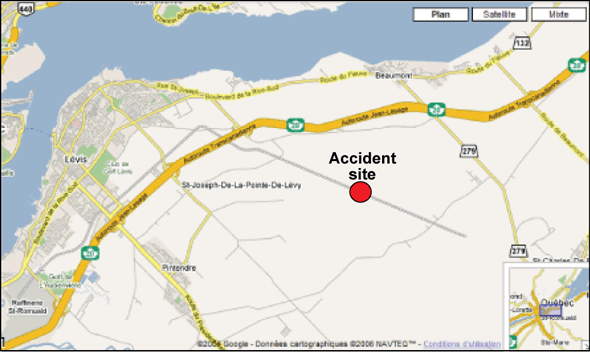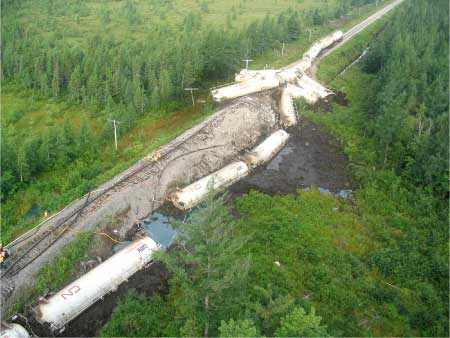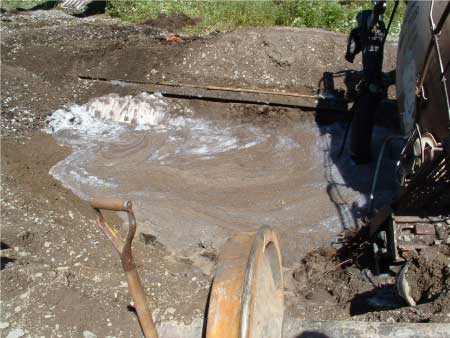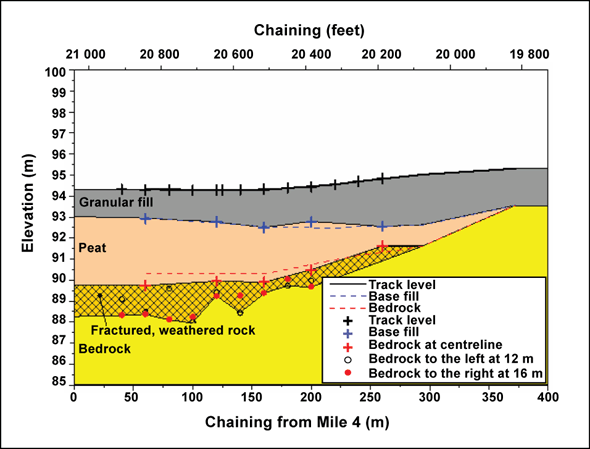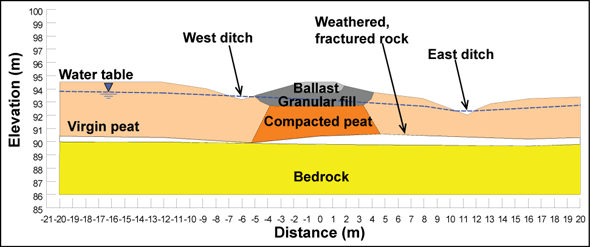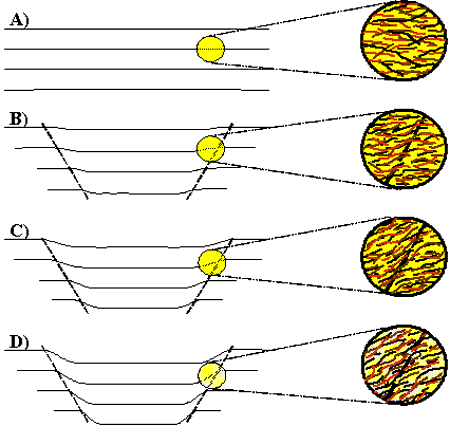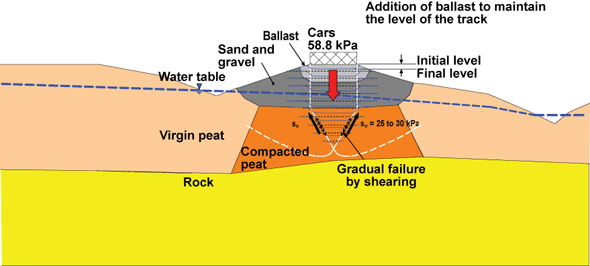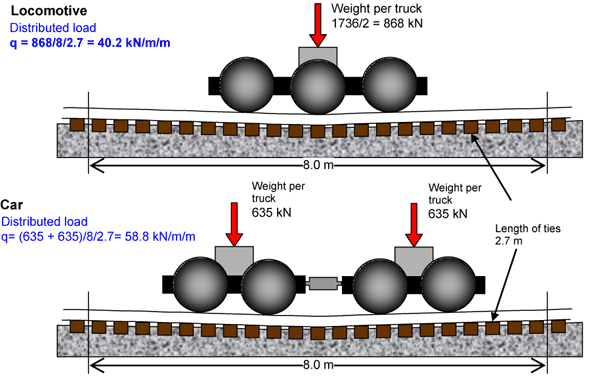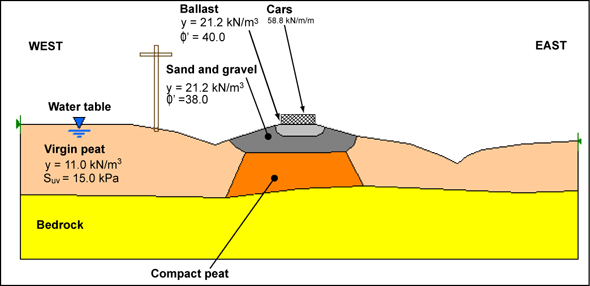Main-track derailment
Canadian National
Train U-781-21-17
Mile 3.87, Lévis Subdivision
Saint-Henri-de-Lévis, Quebec
The Transportation Safety Board of Canada (TSB) investigated this occurrence for the purpose of advancing transportation safety. It is not the function of the Board to assign fault or determine civil or criminal liability. This report is not created for use in the context of legal, disciplinary or other proceedings. See Ownership and use of content. Masculine pronouns and position titles may be used to signify all genders to comply with the Canadian Transportation Accident Investigation and Safety Board Act (S.C. 1989, c. 3).
Summary
At approximately 1440 eastern daylight time on 17 August 2004, 18 tank cars of Canadian National (CN) train U-781-21-17, a petroleum product unit train travelling from the Ultramar Canada Inc. refinery in Lévis, district of Saint-Romuald, Quebec, and bound for Montréal, Quebec, derailed at Mile 3.87 of the Lévis Subdivision, in the marshy area of the Grande plée Bleue, near Saint-Henri-de-Lévis. Approximately 200 000 litres of gasoline and diesel fuel spilled into the marshy area, but the spilled product was recovered. There were no injuries.
1.0 Factual information
1.1 The accident
At approximately 1440 eastern daylight timeFootnote 1 on 17 August 2004, Canadian National (CN)Footnote 2 train U-781-21-17 (the train), travelling from the Ultramar Canada Inc. (Ultramar) refinery in Lévis, district of Saint-Romuald, Quebec, was bound for Montréal, Quebec. The train had covered a distance of 11.2 miles when a train-initiated emergency brake application occurred. The train crew followed emergency procedures and determined that 18 cars (22nd to 39th cars) had derailed.
Before the emergency brake application, the crew did not observe any irregularity in the operation of the train or condition of the track.
1.2 Damage
The 39th car on the train remained upright 100 m north of the primary derailment site, its leading truck having derailed on the east side of the main track. The preceding eight cars jackknifed and plowed into the peat surface (see Photo 1). The other cars rolled over parallel to the east side of the track. Right behind the 29th car, the track collapsed and a depression is noted at the centre of the track (see Photo 2). A total of 250 m of track was destroyed.
The derailed cars sustained damage to their underframe, trucks, body bolsters, and brake rigging. The tank shells of three cars were breached. The tank heads of three cars were breached and the other cars showed minor shell denting. The flexible loading couplings between some of the cars pulled apart. The elbow connection on one car was damaged. Approximately 200 000 litres of gasoline and heating oil spilled but were recovered without permanent environmental damage.
1.3 Emergency response
The City of Lévis Public Safety Department was notified immediately after the accident and authorities implemented the city's emergency plan. In addition to the Lévis Fire Department and CN staff, representatives of various levels of government, the petroleum industry, and clean-up companies arrived at the site at different intervals.
Hydrocarbon fumes affected air quality in the immediate area of the accident site, which required the area within a one-kilometre radius of the derailment site to be cordoned off and evacuated for a period of four days. Hydrocarbon cleaning and recovery operations started once the liquid and vapour leaks were controlled. The hydrocarbons that spilled into the ditches and marshy areas were contained by booms and dikes to limit the spread of the contamination. Two clean-up companies subsequently recovered the hydrocarbons and decontaminated the water and soil.
1.4 Train information
The train was powered by 2 locomotives, measured approximately 4040 feet in length and weighed some 8170 tons. It was made up of 68 loaded tank cars divided into four blocks. The first two blocks were loaded with heating fuel (UN 1202), and the last two were loaded with gasoline (UN 1203). An inspection of the train and a brake test were conducted before departure from Saint-Romuald. No irregularities were identified.
The cars are permanently coupled in 17-car blocks, with piping and related equipment that allows loading or unloading of the entire block from a single connection at one end. The cars are used to transport hydrocarbons between the Ultramar refinery at Saint-Romuald and distribution centres in Montréal, Quebec, Maitland, Ontario, and Miramichi, New Brunswick.
1.5 Personnel information
The train crew consisted of a locomotive engineer and a conductor. Both were qualified for their respective positions and met fitness and rest standards.
1.6 Recorded information
The event recorder on the lead locomotive indicates that, when the emergency brakes were applied, the train was travelling at a speed of 38 mph and the throttle was in position 8.
1.7 Weather conditions
On the day of the accident, the temperature was 23°C, with a slight wind blowing from the west at 15 km/h. The sky was clear. In the 30 days preceding the derailment, the region had received 96 mm of rain, which is close to seasonal averages.
1.8 Occurrence site information
The derailment took place in a section where the track crosses a marshy area known as the Grande Plée Bleue. In April 1999, in the same area, at Mile 3.85,Footnote 3 there was a 10-car derailment (TSB report R99Q0019) caused by a broken splice bar resulting from cross-level defects at the rail joints.
Examination of the derailed cars did not reveal any pre-existing defects that might have contributed to the derailment. An axle with a shifted wheel and three pieces of broken rail were recovered on site and sent to the TSB Engineering Laboratory for examination. The TSB Engineering Laboratory examination (report LP 157/2004) of the shifted wheel and three pieces of broken rail revealed that the wheel displacement and rail fractures resulted from excessive, instantaneous stresses during the derailment.
Cross-level variation was measured to the north of the last derailed car, between Mile 3.905 and Mile 3.955, and found to be between 12 mm and 20 mm; the maximum allowable cross-level variation limit set out in CN's Standard Practice Circular (SPC) 3101 and Transport Canada (TC)-approved Railway Track Safety Rules (TSR) is 44 mm.
1.9 Particulars of the track and subgrade
Following the derailment in 1999, significant rehabilitation work was done to reinforce the roadbed between Mile 3 and Mile 5.9. Rail joints were eliminated, and 132-pound continuous welded rail was installed. New No. 2 hardwood ties were laid at a rate of 3200 ties per mile of track. New double-shouldered tie plates and the rail anchors were installed. The ballast depth was increased and the track was resurfaced. A berm and new ditch were constructed on the east side of the track.
1.10 Subdivision information
The Lévis Subdivision extends approximately 15 miles between Saint-Charles (Mile 0.0) and the Ultramar refinery in Saint-Romuald (Mile 14.97). The main track is a single track running in a north-south direction. Train movements are governed by the Occupancy Control System (OCS) in accordance with the Canadian Rail Operating Rules (CROR) and special instructions from CN, and are supervised by a rail traffic controller based in Montréal. The track is Class 3 according to the TSR. The maximum permissible speed on the track was 40 mph for freight trains.
The line was built between 1879 and 1884. From 1987 to 1995, annual railway traffic totalled approximately 850 000 tons and included both passengerFootnote 4 and freight trains. Following the introduction in 1996 of unit trains carrying hydrocarbons from the Saint-Romuald refinery, traffic has gradually increased to reach approximately 6 million tons annually. Train frequency is dictated by the demand for hydrocarbons and, on average, there are four trains per day in peak periods. Authorized loads for the track are set out in Table 1.
| Period | Locomotives | Cars | |
|---|---|---|---|
| Passenger | Freight | ||
| 1879-1920 | 75 (8-10 axles) | 50 (4 axles) | 40 (4 axles) |
| 1920-1950 | 140 (14 axles) | 90 (6 axles) | 75 (4 axles) |
| 1950-1960 | 135 (4 axles) | 70 (4 axles) | 100 (4 axles) |
| 1960-1990 | 175 (6 axles) | 70 (4 axles) | 131.5 (4 axles) |
| Since 1990 | 195 (6 axles) | 70 (4 axles) | 131.5 (4 axles) |
A detailed analysis of train movement and traffic distribution, conducted for the two-month period preceding the accident, did not reveal any significant change in traffic patterns in terms of train frequency or tonnage.
1.11 Track inspections
Since the 1999 accident, the track has been inspected three times a week, while the inspection frequency required under the TSR is twice weekly.
During an inspection by a track geometry vehicle on 07 May 2004, cross-level variation was determined to be approximately 20 mm in the vicinity of the derailment point. CN indicated that the track had been resurfaced on 30 July 2004, two weeks before the accident.
The most recent ultrasonic inspection for internal rail defects in the area of the derailment was done on 03 August 2004, and no defects were found.
The assistant track supervisor, along with the CN regional head engineer and the TC infrastructure inspector, conducted the last visual inspection from a hi-rail vehicle on 16 August 2004, and noted no geometry defects.
1.12 Track infrastructure
1.12.1 Stratigraphic profile
Several boreholes drilled between Mile 4.2 and Mile 3.75 were used to establish the stratigraphic profile along the centre of the track and to install the required instrumentation for the real-time data acquisition systems to measure pore water pressure variations and vertical deformation in the soil pressure. The stratigraphic profile along the centre of the track was established as set out in Figure 2, while Figure 3 shows a cross-section of the railway track. The bedrock is found from depths of 3 to 5 m. It is a reddish-brown to greenish-grey schist, fractured and very friable. The level of the water table is at approximately 1.0 m under the railway track and is located in the fill layer.
The depth of the ballast layer varies between 0.3 and 0.9 m. The ballast is composed of gravel with a particle size composition of 94 per cent coarse aggregate (gravel) and 6 per cent of fine granulate (sand and silt). The ballast rests on a layer of fill consisting of brown to grey coarse sand containing some silt. The depth of the layer varies between 0.6 and 1.2 m.
The bed rests on a layer of peat with a varying depth of between 1.5 and 3.0 m, decreasing southwardly. It is a black, highly compressible fibrous peat with a moisture contentFootnote 5 of between 325 per cent and 841 per cent with values in the range of 500 per cent under the railway track. The specific density of the peat is approximately 1000 kg/m3.
1.12.2 Gathering of train passage data
Pore pressure and vibrations in the peat and the vertical motion of ties under the repeated loads imposed by car axles were measured using pressure and motion sensors and recorded automatically in data acquisition systems.
In total, 10 data records were recorded with loaded trains and 5 with empty trains between 21 June and 06 November 2006. Two trains passed at a speed of 15 mph, seven others passed at 10 mph and the final train passed at 5 mph. In addition, on 08 October 2006, a train stopped at the site to determine the behaviour of the railway track under a static loading condition.
1.12.3 Vertical rail movement and pore pressure
When trains pass over tracks, maximum instant vertical rail movement values are between 2.0 to 2.5 cm, and increases in pore pressures of between 5 and 20 kPaFootnote 6 were recorded at different measurement points. Average movement and pore pressure values have a tendency to increase with the number of cars passing, thereby creating an accumulation at the end of the train's passage. Once the last car has passed, the excess pressures dissipate gradually; however, there continues to be residual settling of some few tenths of millimetres (see Appendix A).
1.12.4 Cumulative settlements
Residual settlement caused by each train builds up as a result of repeated passages, especially for heavily loaded trains. Residual settlement measured with a string potentiometer, following the passage of approximately 100 trains, are 0.5 cm at Mile 3.93 and 1.0 cm at Mile 3.96. In addition, survey measurements, which were taken on 13 June and 20 October 2006, reveal that, during this four-month period, residual settlement of between 0.5 cm and 2 cm occurred between Miles 3.87 and 3.96. Between 1996 and 2004, cumulative settlement of the peat was 30 cm (see Appendix B).
1.12.5 Influence of the water table level
The side ditch was blocked temporarily on 05 October 2006, at around Mile 4, with wooden sheet piles to raise the water table level. The water level upstream of the sheet piles stabilized at a height of 80 cm above the initial water level in the ditch. The purpose of increasing the water table level was to replicate the water conditions at the time of the 1999 and 2004 derailments. The increase in the water level table affects mainly the hydrostatic pressure, while pore pressure variations during train passages have a minimal effect on this factor. The sheet piles were dismantled on 23 October 2006 to re-establish the normal flow in the ditch and allow the water table to return to its natural level.
1.12.6 Influence of axle load and speed
Repeated train passage results in pore pressures that are at their maximum at the centre of the peat layer. Results indicate that the intensity of excess pore pressures depends on the axle load and train speed. Data recorded by very accurate electric piezometers at speeds of 5, 10 and 15 mph can be used to estimate that excess pore pressures in the peat when travelling at a speed of 38 mph would be approximately 25 kPa.
1.12.7 Scope of the influence area
According to pore pressure surveys, the train's load effect influence area is mainly limited to the area located directly beneath the railway track. Differential piezometer recordings taken with an electric piezometer reveal that excess pore pressures in the peat while trains passed occurred in a transversally limited area of approximately 2 to 3 m on either side of the centre of the railway track.
1.13 Geotechnical studies
1.13.1 Geotechnical studies commissioned by the TSB
1.13.1.1 Québec geotechnical firm
In September 2004, a geotechnical study was contracted by the TSB to a Québec geotechnical firm, which worked in conjunction with the Civil Engineering Department at Université Laval. The study, which included cyclic load triaxial testing, was completed in late May 2005. It determined that the peat's bearing capacity was sufficient to support the weight of locomotives and cars but that the soil under the railway track compresses and undergoes settling that intensifies exponentially with increased cyclic loading.
1.13.1.2 Université Laval
In May 2006, the TSB contracted with the Civil Engineering Department at Université Laval to conduct an additional geotechnical study. The study consisted of characterizing the geotechnical behaviour of the peat under train traffic, particularly by measuring changes in pore water pressure, vertical movement, and permanent settlement based on the number of axle passes.
The study, completed in January 2007, concluded that the railway fill placed over the peat deposit is stable in the event of slope failure under the load of rail cars (see stability analysis in Appendix C). The derailment would not be related to slope instability (overall foundation instability) but rather to punching failure.
According to the study, settlement accumulation in the peat occurred beneath the railway track only, which results in fibre distortion, as the peat outside of the influence area does not experience settlement (see Figure 4). This distortion leads to a realignment of the peat's fibre until it forms two shear planes that develop gradually as the permanent settlement under the railway track increases.
Each time a loaded train passes, the fibres sustain increased shear stress and, just like in the centre of the layer, the excess pore pressure reduces the effective stresses, and a gradual failure mechanism begins. The fibres are gradually broken from the centre of the peat. When the loading imposed by the trains along the shear planes reaches the shear strength of the peat, a punching failure will occur (see Figure 5). This type of failure is accompanied by sudden significant settlements.
1.13.2 Canadian National's geotechnical evaluation
While the studies undertaken by the TSB were underway, CN retained the services of a specialty firm to conduct a geotechnical investigation of the site's soil and water conditions. The study, which was completed in July 2005, concluded that pore pressure and vibrations in the peat, measured while trains were travelling at a speed of 10 mph, were relatively weak and that the stability of the fill and underlying peat was sufficient, with a factor of safety of 1.64Footnote 7 under the effect of the weight of the rolling stock.
1.14 Industry initiatives
In Canada, 2 per cent of rail accidents are related to geological hazards such as rock falls, landslides, and washouts. However, these accidents account for 12 per cent of the direct costs of all rail accidents, in part because they often take place in remote locations and result in long service outage times.
Since 1992, the TSB has investigated six accidents related to the stability and collapse of track infrastructure built on a base of glaciolacustrine silts or peat (reports R92T0183, R94W0101, R97T0097, R97D0113, R97V0063 and R98V0100). Following the accidents at Nakina, Ontario (report R92T0183), and Conrad, British Columbia (report R97V0063), the Board issued recommendations to mitigate roadbed stability-related risk caused by water saturation.
Following the TSB recommendations, a Railway Ground Hazard Research Program was established in partnership with the Canadian railway industry, federal agencies, and universities.
In partnership with Natural Resources Canada's Geological Survey of Canada, CN and Canadian Pacific Railway (CPR), the Centre for Risk Assessment and Geohazard Studies was established in 2003 at the University of Alberta to oversee the research program. Queen's University has joined the program as an active technical participant. The Natural Sciences and Engineering Research Council provided a research and development grant in April 2004. A collaborative research agreement was reached in April 2005 between TC, Natural Resources Canada, CN, CPR, and the University of Alberta.
The purpose of the program was to set up an integrated database on geological incidents, the development of geological characterization and hazard prediction methods as well as the development of a monitoring and detection technology prototype. The objective is to develop risk management solutions to improve the safety of Canada's rail infrastructure and reduce losses caused by geological incidents. One of the projects carried out in the program consisted of the development of ground penetrating radar as a tool for conducting profiling of long sections of track ballast and subgrades.
1.15 Tank car construction
The tank cars involved in the derailment were uninsulated, non-pressure tank cars built to specification DOT 111A100W1 (Class 111A). All tank cars were constructed in 1995 and 1996 under permit SR 4949, granted by TC. The tank shells and heads were constructed with 7/16-inch-thick Association of American Railroads (AAR) TC-128 Grade B steel. The cars were not equipped with head shield protection. The construction certificate indicated that they were built for a maximum weight of 286 000 pounds; however, they are limited to a gross weight of 263 000 pounds.
TSB investigations R94C0137, R95D0016, R99D0159 and R05H0011 identified this type of car as susceptible to puncture and more likely to release content when involved in an accident. In its investigation of occurrence R94C0137, the Board recommended that:
The Department of Transport take immediate action to further reduce the potential for the accidental release of the most toxic and volatile dangerous goods transported in Class 111A tank cars-for example, require design changes to improve tank car integrity in crashes or further restrict the products that can be carried in them.
Transportation Safety Recommendation R96-13, issued November 1996
TC agreed with the recommendation and has overseen design improvements on new Class 111A tank cars that provide better protection to valves in the event of a rollover. In addition, the Canadian tank car standard (CAN/CGSB-43.147), adopted by reference in the Transportation of Dangerous Goods Regulations, has been amended to restrict the number of products that can be carried in Class 111A tank cars.
The maximum gross weight on rail, established in standard CAN/CGSB-43.147, for tank cars in dangerous goods service, is 263 000 pounds. In 1999, TC, the United States Department of Transportation (DOT) and the Federal Railroad Administration (FRA) issued a joint "White Paper," establishing additional design standards under which TC permits and United States exemptions could be issued for Class 111A tank cars with a gross weight of 286 000 pounds. These additional standards have been integrated into the AAR Specifications for Tank Cars, M-1002-2003. Since 2003, in Canada, TC has required all Class 111A cars carrying more than 263 000 pounds to meet these standards, which include higher puncture resistance through better material selection, half-head shields and improved protection of service equipment such as valves. These additional requirements do not apply to Class 111A tank cars with a gross weight of 263 000 pounds or less, or to other non-pressurized cars, even though they represent the majority of newly constructed cars.
2.0 Analysis
An examination of the rolling stock and the train's operation determined that they did not contribute to the accident. An in-depth study of train operations, conducted for the two-month period preceding the accident, did not reveal any significant change in traffic patterns in terms of train frequency, interval, or tonnage. In the 30 days preceding the derailment, precipitation in the region was close to normal. Therefore, neither the train's operation nor the weather conditions played a role in the accident. Thus, the analysis will focus on the track infrastructure and the integrity and resistance of the tank cars used in the transport of hydrocarbons.
2.1 Roadbed stability
2.1.1 Resistance to slope failure and capacity rating
The studies conducted by both the TSB and CN determined that the stability at slope failure and the capacity rating of the peat were sufficient to support the weight of the locomotives and cars, but that the soil under the rail track compresses and incurs settlement. A conservative evaluation of the risk of slope failure reveals that the railway fill placed over peat deposits is stable in the event of slope failure under the load of the cars and locomotives.
2.1.2 Punching failure
Observations made during the monitoring of peat behaviour under repeated loads resulting from train passage indicated that the excess pore pressure at the centre of the peat could reach values of at least 25 kPa when loaded trains travel at 38 mph. These excess pressures reduce the shear strength of the peat by decreasing the effective confining stress and result in permanent settlement during their dissipation.
Real-time measurements of vertical movement under the railway confirmed that these permanent settlements can be at a rate of several centimetres per year. Even if maintenance work is performed regularly by CN maintenance crews to correct the surface track and ensure that geometry standards are observed at all times, the permanent settlements continued to accumulate in the peat under the railway track only. Over the eight years before the derailment, these settlements could have reached a value of 30 cm.
According to the Civil Engineering Department of Université Laval, this phenomenon results in fibre distortion and realignment of the peat fibres until the formation of two shear planes that develop gradually as the permanent settlement under the railway track increases. Once the shear strength of the peat is reached, a sudden failure caused by punching could occur. This type of failure is accompanied by sudden collapse of the railway track, as confirmed by the depression observed at the centre of the track behind the 29th car. The accident occurred when the cars were unable to negotiate the sudden collapse of the track resulting from the failure of the subgrade most likely caused by punching and thus derailed.
2.1.3 Identification of sites susceptible to punching
The study commissioned by the TSB has identified certain contributing factors to the punching phenomenon such as the axle weight, tonnage, and train speed. It also revealed that the areas where the subgrade of the track were built on saturated peat and where surfacing work is required regularly to maintain the profile of the track are areas susceptible to punching. Frequent surfacing work suggests the existence of cumulative and permanent settlements in the peat, and thus the potential for shear plane formation and, ultimately, punching failure. The shear punching mechanism integrated results from tests performed in the laboratory and in the field and was consistent with site observations. Therefore, it is the most plausible explanation for the subgrade failure. However, additional studies are required to better understand this phenomenon.
The industry has taken important initiatives such as the Railway Ground Hazard Research Program to better understand, identify, and mitigate risks relating to geology and the behaviour of the ground underneath railway tracks. These initiatives were focused mainly on slope stability in hilly areas and on the behaviour of soils of glaciolacustrine origin, even though the recent development of the ground penetrating radar technology could potentially help detect problematic areas such as cumulative settlement over peat. Including other ground types such as peat and the examination of other types of failure such as punching will allow the industry to better understand, identify, and prevent the risk of failure in several types of soil and reduce the risk of derailment.
2.1.4 Track and subgrade inspection and maintenance methods
Following the derailment in 1999, CN took measures to reinforce the track infrastructure and increased the frequency of inspections. The installation of new ties and continuous welded rails and the addition of ballast confirm the good condition of the track. Maintenance work was performed regularly to maintain the track surface, most recently performed two weeks before the accident. The assistant track supervisor, along with the CN regional head engineer and the TC infrastructure inspector, visited the site two days before the accident and noted no geometry defects. Accordingly, indications are that there were no early signs and that the track appeared to be in good condition; the track failure occurred suddenly and without warning.
Railway inspection technologies and procedures are based mainly on evaluations of track conditions at surface level. They are effective for observing track settlements; however, the distortion of peat fibres or, rather, the level of progression thereof in the peat layer cannot be seen by the naked eye or during surface inspections. Accordingly, the impending risk of collapse is very difficult to detect under such circumstances.
2.2 Impact resistance of class 111A tank cars
The tank cars involved in the derailment, though compliant with AAR Standard S-259-94, were not equipped with half-head shields because they were built before the "White Paper" and the AAR Specifications for Tank Cars, M-1002-2003, were published.
The tank shells and heads were breached as a result of the impact when the tanks jackknifed. In addition, the isolation valves and rollover protection systems were ineffective and, as a result, there was a significant spill of hydrocarbons.
On several occasions, the TSB clearly revealed the vulnerability of Class 111A tank cars when used in the transport of hydrocarbons, which resulted in the industry and TC taking certain measures to mitigate risk in the event of a derailment. The number of products that these cars are allowed to transport was reduced when the Transportation of Dangerous Goods Regulations were amended and new tank car construction standards were established.
The safety enhancements included in the standards do not apply to Class 111A tank cars with a maximum gross weight of 263 000 pounds or less, or to other non-pressurized tank cars, even though they represent the majority of recently built cars. Furthermore, the project "Next Generation Tank Car" initiated by TC, the FRA and the industry, concerns only the construction standards of high-pressure tank cars used to transport hazardous goods. Therefore, a large number of tank cars carrying dangerous goods are not reinforced and are vulnerable to punctures and will continue to present risks of puncturing, even during derailments at moderate operating speeds.
2.3 Emergency response
The rapid response of the City of Lévis Fire Department and the immediate application of the emergency measures plan resulted in well-controlled access to the site and protection of the public and other stakeholders on the site. Hydrocarbon and contaminated soil clean-up and recovery operations were carried out methodically and in an environmentally responsible manner.
3.0 Findings
3.1 Findings as to causes and contributing factors
- Track subgrade settlements accumulated under the repeated effect of loads gradually resulted in distortion and realignment of peat fibres, which most likely led to the sudden punching failure.
- The cars were unable to negotiate the sudden collapse of the track brought on by subgrade failure and thus derailed.
3.2 Findings as to risk
- Areas where the track subgrade was built on saturated peat and where surfacing work is required on a regular basis to maintain track profile are those areas that are susceptible to punching.
- Axle weight, tonnage, and train speed are factors that could contribute to the punching phenomenon.
- Railway inspection procedures and technologies, based on surface observations, are not able to detect the impending risk of collapse.
- Despite measures taken by the regulator and the industry, most non-pressurized tank cars used in the transport of hydrocarbons and other dangerous goods remain vulnerable to puncture and continue to present risks, even following impacts at moderate operating speeds.
3.3 Other findings
- Further research is required to better understand shear punching failure.
- A conservative evaluation of the risk of slope failure reveals that the railway fill placed over peat deposits is stable in the event of slope failure under the load of the cars and locomotives.
- The response of the City of Lévis fire department was effective and successful in protecting the public and others on the site.
4.0 Safety action
4.1 Action taken
On 19 August 2004, Transport Canada (TC) imposed a speed restriction of 25 mph between Mile 1.0 and Mile 6.0. In the immediate vicinity of the derailment, the speed was reduced to 10 mph.
In June 2006, after several accidents in the United States involving hazardous material spills, the Federal Railroad Administration (FRA) started an in-depth assessment of the construction standards of tank cars used to transport hazardous goods with a view to minimizing the risk of spills occurring during derailments. TC is working closely with the FRA to address the same issues and ensure harmonization. In addition, TC, the FRA, and the industry signed a memorandum of cooperation in April 2007 to develop a better understanding of the factors contributing to high-pressure tank car safety and to enhance the effectiveness of railway specific hazardous material bulk packaging under the project "Next Generation Tank Car."
4.2 Action required
4.2.1 Roadbed stability
The subgrade failure occurred suddenly and without warning when all indications were that the track was in good condition and that there were no early signs of distress. The railway inspection technologies and procedures, mainly based on evaluations of track conditions at surface level, were not effective to assess the condition and the behaviour of the subgrade and detect the impending risk of collapse.
Many miles of Canadian railway tracks are built along rivers or across marshy areas where peat is present. Therefore, these locations are exposed to the conditions encountered in this occurrence. Given these circumstances, a better understanding of the failure mechanism and the effect of railway loading on peat subgrade is needed to mitigate the risks inherent to these types of organic soils.
The Board recognizes the efforts by the railway and the regulator to address the issues related to soil and rock slope stability. Industry has taken important initiatives such as the Railway Ground Hazard Research Program to better understand, identify, and mitigate risks relating to geology and the behaviour of railway track subgrade. These initiatives were focused mainly on slope stability and on the behaviour of soils of glaciolacustrine origin, even though the recent development of ground penetrating radar technology could potentially apply to peat areas.
The study commissioned by the TSB and carried out by the Civil Engineering Department of Université Laval determined punching shear as a failure mechanism. It also indicated that the areas where the tracks were built on saturated peat, and where surfacing work is required regularly to maintain the profile of the track, are areas susceptible to punching. The shear punching mechanism was consistent with site observations and integrated results from tests performed in the laboratory and in the field. However, additional research efforts are required to enhance understanding of their phenomena and reduce risk. Therefore, the Board recommends that:
The Department of Transport and the railway industry conduct in-depth studies on the behaviour of saturated organic materials under cyclic loading.
Transportation Safety Recommendation R07-03
4.2.2 Non-Pressurized Tank Car Standards
The damage sustained by the Class 111A tank cars involved in this occurrence and the risks posed by the subsequent product release are typical of that identified in previous TSB investigations. In this occurrence, there was a significant spill of hydrocarbons when the tank shells and heads were breached even though the derailment happened in a marshy area where the surrounding terrain was particularly soft. Other occurrences investigated by the TSB have also revealed the vulnerability of this type of car to puncture, even in low-speed accidents (TSB report R99D0159 [Cornwall] and TSB report R05H0011 [Maxville]).
The Class 111A tank cars' weaknesses have been acknowledged by the regulator and industry, resulting in measures to mitigate risk in the event of a derailment. The number of products that these cars are allowed to transport was reduced when the Transportation of Dangerous Goods Regulations were amended and new tank car construction standards were established by TC. These standards, which have been incorporated into the Association of American Railroads (AAR) Specifications for Tank Cars, M-1002-2003, require that new Class 111A tank cars with a gross weight of 286 000 pounds be constructed to more stringent criteria, including improved puncture resistance through better material selection and inclusion of half-head shields. However, the safety enhancements included in the standards do not apply to Class 111A tank cars with a maximum gross weight of 263 000 pounds or less, or to other non-pressurized tank cars. Consequently, a large number of the existing tank cars carrying dangerous goods will be vulnerable to puncture, even during derailments at moderate operating speeds.
Considering that the difference in product volume between the two types of car is less than nine per cent, the risks presented by a product release from a 263 000-pound car would not be significantly lower than in the case of a 286 000-pound car. Therefore, the Board believes that further attention is required to address the issue of puncture resistance of cars of lower weight and recommends that:
The Department of Transport extend the safety provisions of the construction standards applicable to 286 000-pound cars to all new non-pressurized tank cars carrying dangerous goods.
Transportation Safety Recommendation R07-04
This report concludes the Transportation Safety Board's investigation into this occurrence. Consequently, the Board authorized the release of this report on .
5.0 Appendices
Appendix A - Vertical movement and pore pressure
Appendix B - Cumulative settlements
There are two ways to estimate cumulative settlements that have occurred since 1996. The first involves multiplying the alignment cross-level deviation value (which, for Class 3 tracks, is 25 mm for priority level intervention or 44 mm for emergency level intervention) by the number of Canadian National (CN) interventions between 1996 and 2004. The second method consists of applying the relation (obtained from the results of triaxial testing under drained conditions) between the change in standardized settlement of the peat, s/Ho and the number of loading cycles.
Given that the number of interventions between 1996 and 2004 was between 8 and 12, at a correction rate of 25 mm per intervention, the first method gives a cumulative settlement in the peat of 20 to 30 cm.
By using the relationship between the evolution of the standardized settlement of the peat and the number of loading cycles, the total relative settlement for peat that is 2.0 m thick would be 32 cm for a number of axles, between 1996 and 2004, of 300 000.
Appendix C - Stability analysis (Slope failure)
The average load applied by a loaded train was estimated by considering that the load of a group of axles divided over a length of approximately 8 m. For the locomotive, the equivalent vertical stress applied under the ties is 40.2 kPa and for the cars, the value is 58.8 kPa (see Appendix C1).
Stability calculations were made with the SLOPE/W software application using the simplified Bishop method to verify factors of safety in relation to fill failure by a bed surface moving the layer of peat. The section used at Mile 3.87, near the derailment point, where the fill was raised by approximately 1.0 m in relation to the natural ground level on the east side of the railway track, was analyzed.
Stability calculations were made bearing in mind shear strength of 24 kPa, 12 kPa and 10 kPa. Shear strength calculations were made using a field vane. The minimum shear resistance (Suv) value of the peat is approximately 12 kPa, while the average value is 24 kPa. Maximum values of 48 kPa were also measured. These Suv values consider only the overload caused by the weight of the fill. In the virgin peat adjacent to the railway track, an Suv strength of 15 kPa was used.
For a train travelling at 38 mph, the following factors of safety at the slide were obtained:
| Shear strength | Factor of safety |
|---|---|
| 24 kPa | 1.826 |
| 12 kPa | 1.492 |
| 10 kPa | 1.388 |
| 5 kPa | 1.0 |
The results of the stability analysis for shear strength of 10 kPa are shown in Appendix C2.
A factor of safety of 1.0 (slope becoming unstable) is obtained when Suv = 5 kPa, which is physically impossible. Accordingly, the railway fill built on the peat deposit is stable under the circumstances in terms of slope failure under the load of cars.
Appendix C1 - Vertical movement and pore pressure
Appendix C2 - Stability analysis of track fill slopes at mile 3.87
Appendix D - Glossary
- AAR
- Association of American Railroads
- CGSB
- Canadian General Standards Board
- cm
- centimetres
- CN
- Canadian National
- CPR
- Canadian Pacific Railway
- CROR
- Canadian Rail Operating Rules
- DOT
- Department of Transportation (United States)
- FRA
- Federal Railroad Administration
- kg/m3
- kilograms per cubic metre
- km/h
- kilometres per hour
- kN
- kilonewtons
- kN/m3
- kilonewtons per cubic metre
- kPa
- kilopascals
- m
- metres
- mm
- millimetres
- mph
- miles per hour
- OCS
- Occupancy Control System
- SPC
- Standard Practice Circular
- Suv
- shear resistance
- TC
- Transport Canada
- TSB
- Transportation Safety Board of Canada
- TSR
- Railway Track Safety Rules
- Ultramar
- Ultramar Canada Inc.
- y
- unit weight
- °C
- degrees Celsius
- ø'
- internal angle friction
